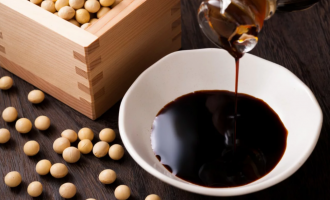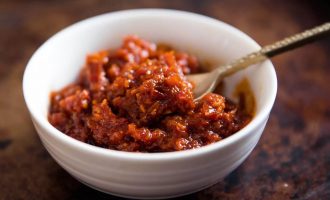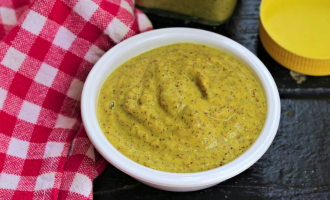Soy sauce, a beloved condiment with a rich history spanning over 2,500 years, originates from China. It’s the result of fermenting soybeans with wheat, salt, and fermenting agents, creating a complex, savory liquid that enhances the flavor of countless dishes. This sauce has seamlessly integrated into various cuisines around the globe, particularly in Asian culinary traditions. It’s commonly served with sushi, stir-fries, marinades, and as a dipping sauce, showcasing its versatility.
- Soybeans 50 g
- Wheat 50 g
- Salt 100 g
- Water 900 ml
- Fermenting agents As required
- Mix soybeans and wheat. Roast the wheat lightly until aromatic and crush it slightly.
- Combine the soybeans, wheat, and fermenting agents in a clean container. Allow the mixture to ferment for 3 days at room temperature, stirring daily to prevent mold growth.
- Dissolve the salt in the water to create a brine solution. Combine the brine with the fermented soybean and wheat mixture. Transfer to a larger container.
- Cover the container with a breathable cloth and let it ferment for 6 to 12 months in a cool, dark place. Stir the mixture monthly to ensure even fermentation.
- After fermentation, strain the mixture through a cheesecloth to separate the liquid soy sauce from the solids.
- Boil the liquid for 20 minutes to pasteurize it, enhancing its flavor and shelf life.
- Cool the sauce and transfer it to sterilized bottles. Seal tightly.
Storage Tips
- Store soy sauce in a cool, dark place before opening.
- After opening, keep it refrigerated to maintain its quality and extend its shelf life.
- Properly stored, soy sauce can last several years, with its flavor maturing over time.
Useful Properties of Soybeans
Soybeans, the primary ingredient in soy sauce, are incredibly nutritious. They’re a great source of protein, essential amino acids, fiber, and various vitamins and minerals. Soybeans also contain antioxidants and phytonutrients that can contribute to reduced risk of several diseases, including heart disease and certain cancers.
Interesting Facts
- Historical Significance: The production of soy sauce was an important economic activity in ancient China, spreading to Japan in the 7th century.
- Variety: There are numerous types of soy sauce, including light, dark, sweet, and tamari, each offering different flavors and uses.
- Cultural Impact: Soy sauce has played a pivotal role in the culinary traditions of East Asia, symbolizing the blending of flavors and cultures.
Soy Sauce Calorie Content
Soy sauce is relatively low in calories, providing about 100 calories per 100 grams. This makes it an excellent option for adding depth and umami to dishes without significantly increasing their calorie content.
Whether used in cooking or as a condiment, soy sauce’s unique taste and nutritional benefits make it a staple in kitchens around the world. Its long history and cultural significance add an enriching layer to its culinary uses, making it more than just a seasoning, but a bridge between traditions and flavors.







